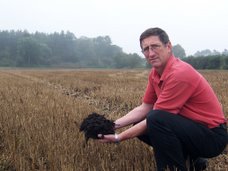Agriculture is the primary market for composts and over 1 million tonnes were used in 2005/06. However, the soil is our greatest natural asset and we need to protect it and preserve it, whilst improving its organic matter and biodiversity. Quality compost, used correctly, is a good way of improving arable soils and reducing their erodibility.
We provide a service called 'Earthcare' to help you apply compot to farmland correctly.
News...
Quality Compost is defined in the Quality Protocol launched in March 2007. At Enviros we have written the web tool to aid the record keeping required. This is available at http://www.qualitycompost.org/. Other 'waste' composts, including that produced under exemption for own use on farm, require a Para 7a exemption for land spreading in agriculture. In 2009, new simplified licences will be used for small scale on-farm composting rather than exemptions.
Compost use fits in well with soil, nutrient and manure managemnt plans as part of Cross Compliance and Environmental Stewardship. I am writing guidelines for WRAP covering these aspects and these will be released soon.
Research
A three year project started in September 2001 in Eastern England was managed by me at Enviros. This was funded by the GrantScape and the British Potato Council/the Applied Research Forum. Seven sites had compost applied in fully replicated trials in combination with artificial fertilizers. Crop yield and quality, nutrient release, soil structure, plant pathogen kill and the effects of compost on soil-borne dieseases have been assessed.
Previous work in agriculture carried out by me at Levington Agriculture is available from the 'media centre, archived reports' section of the Evolve EB website.
The results of year one 2001/02, year two 2002/03 and year three 2003/04 have been assessed. The consolidated report is available from http://www.compost.me.uk/. The project was continued into 2005 and 2006 and the Phase 2 report is also available from that web site, along with useful leaflets summarising the benefits of using compost. WRAP continued to support the trials - on 3 sites in 2007. They have supported trials on a number of other sites and crops including fruit and vegetables in Kent through ReMaDe Southeast http://www.remade-southeast.co.uk/.
Rothamsted carried out assessments on soil physical structure from plots and Reading University investigated irrigation and microbial biomass effects from compost. We also looked at nitrogen release in 2005/06.
Remade Essex had a site in Essex where much greater amounts of compost were applied: zero, 100, 200 and 400 t/ha with sub plots of zero, 40, 80, 120 and 160 kg fertilizer nitrogen in a fully replicated design. The plots were harvested in July 2003 with an additional 1 t/ha oilseed being harvested from 100 t/ha compost over and above inorganic nitrogen effects. See Remade Essex. This site was continued into 2004 (wheat) and 2005 (hemp) with good results, expecially for the hemp.
Remade Essex also managed a series of agricultural projects as part of RMDF from WRAP on erosion and drainage on light and heavy land with my technical input.
Other trials reports from ORA are available at www.o-r-a.co.uk/reports.
Dissemination is through the British Potato Council web site http://www.potato.org.uk/, and also from http://www.compost.me.uk/.
A report on the potential use of compost in organic agriculture is available from the WRAP website http://www.wrap.org.uk/. WRAP have also undertaken surveys of the use of compost in intensive agriculture.
Defra have a project called 'Alowance' which is mapping the land bank available for manures, sewage sludges and composts.
Sunday, 25 March 2007
Subscribe to:
Post Comments (Atom)

No comments:
Post a Comment